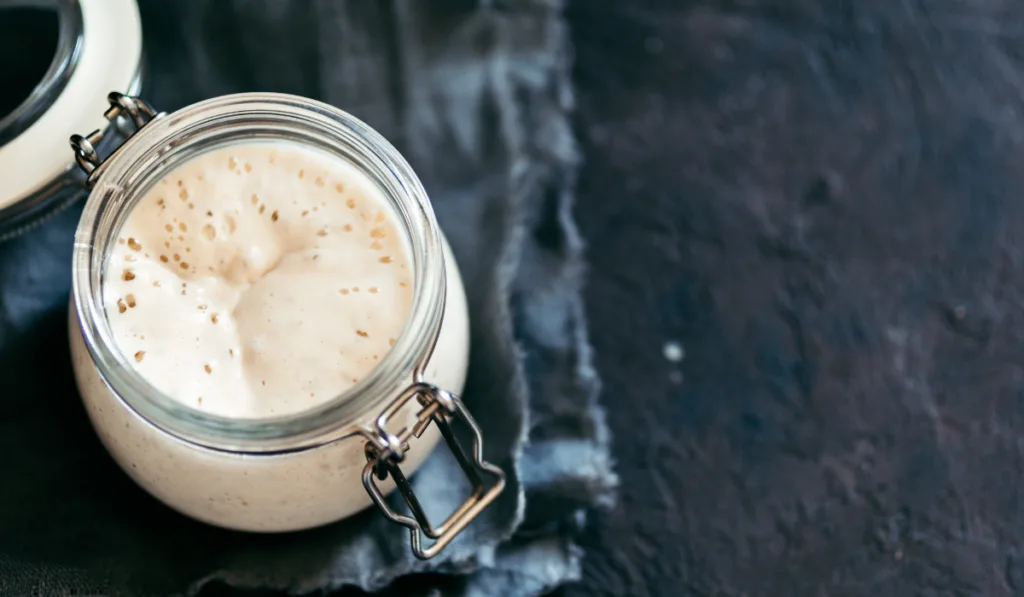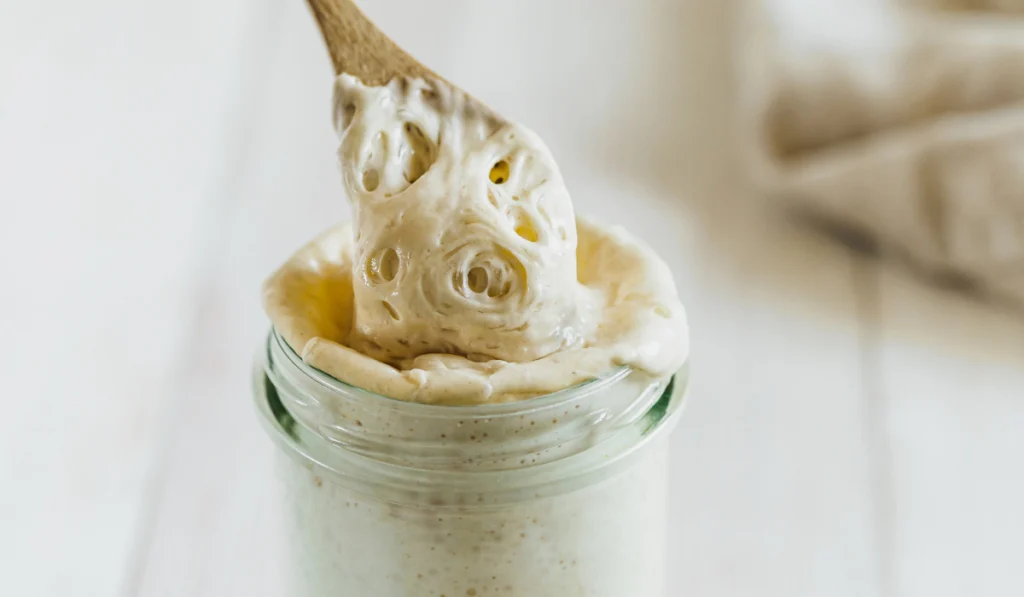You can use a sourdough starter for baking all kinds of tasty breads and rolls. But a sourdough starter needs some TLC to keep it alive and ready to rise.
What happens if you want to go on vacation? Or you don’t have as much time to bake as you used to? It seems a real pity to waste the starter. But there are ways of storing sourdough starter, one of which is freezing.
Sourdough starter can be frozen for up to two weeks, otherwise it will start to degrade. It needs to be frozen immediately after making it and must be revived correctly. To store a sourdough starter for longer periods, you should first dehydrate it.

Most bakers would assume that freezing would kill the yeast and lactic acid bacteria in a sourdough starter. But yeast is exceptionally resilient, and although some dies, the rest simply becomes dormant and goes into ‘hibernation.’
The key is to freeze it quickly and then ‘wake’ the yeast up carefully, feeding it so that it can rise or leaven properly again.
Table of Contents
Why freeze your sourdough starter
Let’s be honest, making a batch of sourdough starter is quite an effort. Starting from scratch, it can take up to seven days. And once you’ve got a starter, you must remember to feed it regularly to maintain its vitality.
If it’s summer, you might find you have too much starter to keep up with, even if you share it with friends.
Freezing allows you to store batches of starter in convenient sizes, ready to use when you want to bake. Even if you add up the freezing, thawing and reviving times, it’s still a lot shorter than starting from scratch.
It’s also convenient to freeze batches of the starter if you want to share some with friends, but won’t be seeing them immediately.
Also, freezing your sourdough starter is helpful when you don’t have time to maintain a batch of starter – maybe you’re too busy to bake or want to take a vacation, but don’t want to throw out your sourdough starter.
How to freeze your sourdough starter
Freezing your sourdough starter is a quick and easy process, but you need to follow specific rules to do it successfully.
1. Freeze your sourdough starter immediately.
You should only freeze a new or fresh batch of sourdough starter. Ripe or mature sourdough starter freezes less successfully than a fresh starter because there won’t be enough food left for the yeast, so it won’t have the nutrients it needs to grow.
Feed your starter about an hour before you plan to freeze it.
2. Divide the starter into the portions you require before freezing.
- Weigh and then spoon the starter into zip-top plastic bags, taking care to squeeze out as much air as possible. Label the bags with the date and then freeze flat. Double-bagging the starter does help to prevent freezer burn.
- If you want to freeze the starter as cubes, pour or pipe the starter into an ice tray, smooth the tops flat and freeze. When they are frozen, put the cubes into labeled zip-top bags for storage.
- You can also use silicone muffin cups for freezing convenient-sized portions.
3. Freeze for no longer than two weeks
Freezing the starter for more than two weeks allows ice crystals to build up, which kills off the yeast. However, some of the bacteria always survive: bakers have successfully used sourdough starter that has been frozen for months at a stretch.

How to use frozen sourdough starter
You can’t use a frozen sourdough starter as is, like a fresh starter, so you will need to plan your baking a couple of days ahead to allow the frozen starter to revive.
When you are ready to bake with the frozen starter, it’s simple to get it going again. Reactivate your frozen starter with these steps.
- Take the amount of frozen sourdough starter you need out of the freezer to thaw overnight in the refrigerator.
- The following day, let the starter continue thawing at room temperature (around 21⁰ C/70⁰ F). You’ll notice that the plastic bag will puff up as it thaws and revives. If you’re using frozen cubes, place them in a bowl and cover them with cling film.
- Depending on the starter, you may need to give it a jumpstart over a day or two. Sourdough starter that has been frozen for a while can be thawed, then put into a jar. Feed it as usual. Cover the jar and leave it for another 12 hours. You may need to feed the sourdough starter again before use.
- Once the starter is growing again, use as required.
Help! I’ve left my sourdough starter in the freezer for too long!
Yeast is such a fantastic organism that even if you leave your starter in the freezer for more than two weeks, the yeast will not die completely. You can still use it for baking.
Allow it to thaw and then discard half of it. Feed it as usual and allow it to grow again. If it seems sluggish, you can still use the starter – you may just have to add some yeast to help it rise. Your bread will still have that characteristic sourdough flavor.

Freezing dried sourdough starter
Bakers who want to preserve their sourdough starter for even longer often choose to dry or dehydrate it and then freeze it.
Dehydration makes the yeast completely dormant so that you can keep your starter indefinitely.
How to dry or dehydrate your sourdough starter
Drying your sourdough starter is easier than it sounds. You can use a commercial dehydrator or follow these simple steps.
- Spread a thin layer of sourdough starter on a silicone baking sheet on a baking tray using a spatula.
- Allow the starter to dry completely either in a cool place or in the oven with the light and fan on. Do not turn on the heat, or else your starter will die. This drying process can take anything between 18 and 24 hours.
- Once the starter is completely dry, turn it over and make sure the other side is dry as well.
- Break the starter up into chips or grind it.
- Store the dried startre in an airtight container, preferably in the freezer.
- A dried sourdough starter can be frozen for years.
How to use dried sourdough starter
Like any frozen sourdough starter, you can’t use a dried starter immediately. You will need to plan ahead a couple of days for the starter to thaw and reactivate. Follow these steps to reactivate the dried starter.
- If the starter is frozen, allow it to thaw in a little warm water. The thawing process may take a couple of hours.
- The starter will not look active yet. You then need to add more warm water and feed the starter before it becomes active again.
- Just as with a regular frozen sourdough starter, allow the starter some time to take in nutrients and reactivate again before using it.

Can I keep sourdough starter in the refrigerator?
If you want to bake regularly, you can refrigerate your sourdough starter for easier access. Simply keep a cup of the starter in the coldest area of the refrigerator.
However, you will still need to feed the starter at least once a month. When you want to use the starter, allow it to thaw at room temperature before using it.
Conclusion
Freezing a batch of sourdough starter is a convenient way of storing your starter when you want to take a break from baking or simply from the chore of maintaining the starter.
If you freeze your starter carefully and for a short period, as long as the sourdough starter thaws successfully it can be used as usual.
If you want to store frozen sourdough starter for longer, it is best to dehydrate it first. Either way, you will always have a stock of sourdough starter on hand to be able to bake delicious bread or rolls.
